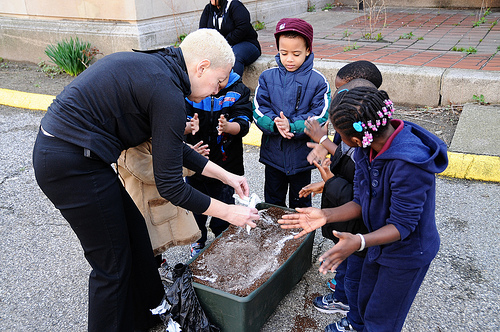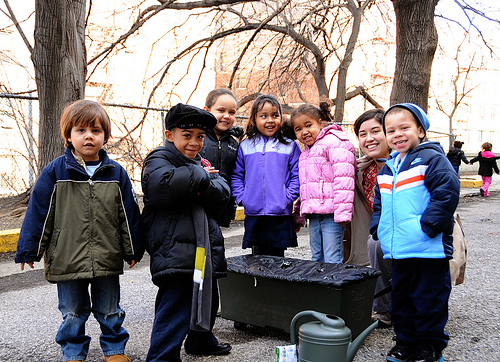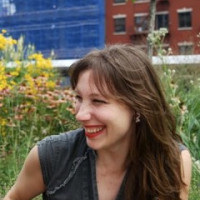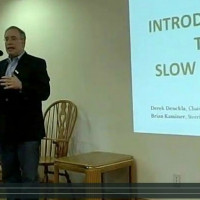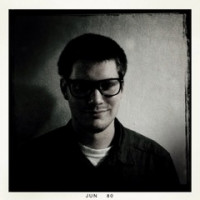Meet Ying Guo of Growing Gardens Growing Kids, a project she founded in the South Bronx aimed at teaching kids how to grow fresh produce. Ying’s project was selected as a pilot project by Pando Projects, a nonprofit organization, founded by Milena Arcisewski, with the mission of providing online tools, funding and mentorship to emerging leaders with ideas that will positively impact communities.
Ying is currently leveraging a customizable website and social media support provided to her by Pando Projects to bring her idea to fruition. Although she is in the throws of ramping up her project, she took time to share more about Growing Gardens Growing Kids and Pando Projects with me. Ying’s project is an inspiring example of how technology can support local activism.
_____________________________
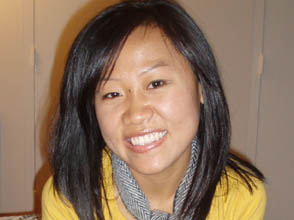 Chitra Agrawal: What is your project about and how does it operate?
Chitra Agrawal: What is your project about and how does it operate?
Ying Guo: Our project, Growing Gardens Growing Kids, is a 4 month project where we help 2 Pre-K programs start a community garden with a specially designed box system called an EarthBox. We are working with Head Start and the Early Learning programs of the Midbronx Council of Services. 17 teachers are regularly trained to integrate a set of curriculum into their classes to teach pre-K children where foods come from, how to grow fresh produce, and what foods are healthy to eat. The classes experience hands-on gardening, and the produce grown from the garden will then be used in the meals and snacks made for the kids.
CA: What is an EarthBox?
YG: An EarthBox is a specially designed box system that allows for low maintenance growing. EarthBoxes produce twice as much product as conventional gardening and does not require as much work. An EarthBox is easy to set up and does not require digging up land. EarthBoxes are also mobile and better facilitates classroom participation in planting a garden. There is no limit to the type of garden plants grown in an EarthBox. They have been successfully used in school-based programs in urban areas.
CA: How’d you come up with the idea? What was your inspiration?
YG: As an Americorps member with Bronx Health REACH, I work on initiatives to help alleviate health disparities in Bronx, NY. Through my work, I come across many individuals who face environmental challenges in improving their health. While doing community outreach in South Bronx, I heard a story about a child who threw away a ripe peach because he did not know what it was, how it tasted, and that it was good for him. I saw the need to provide more access to fresh fruits and vegetables in South Bronx and to teach healthier eating habits. I wanted to work with kids because healthy behavior is best learned starting at a young age and many programs have shown that hands on gardening at young age actually translated to healthier eating choices later on in life. A community garden with EarthBoxes is a great way to provide fresh produce to that community and a great space for kids to be active and learn about where food comes from.
CA: Describe the online workspace that was provided to you by Pando Projects. How are you using this workspace to execute your project and how has it made it easier for you to implement?
YG: Along with mentorship and other resources, Pando Projects provides an online platform in the form of a personalized website for my project idea. The workspace provided by Pando Projects allowed me to share my project idea, to recruit volunteers, to fundraise, to update project members, to organize through an event calendar, and to blog about the progress of my project. It has been extremely useful to have all these options in one website. People who are interested can directly join the project or donate to it directly from the site. Without this platform, I would have been using many separate links and resources and would not have been able to direct donors and friends to just one website.
 CA: What are the most interesting, unexpected things you have learned?
CA: What are the most interesting, unexpected things you have learned?
YG: I have learned to manage details better in executing a project. When I first started, I wasn’t aware of all the fine details that I had to consider in executing. It has helped a lot to have a team of volunteers who support me in arising challenges. I have also learned to really delegate work and to better work as a team.
CA: What have been your greatest challenges?
YG: Some of the biggest challenges have been organization. I think of myself as a pretty organized person and was surprised as to how much organizing was necessary in executing my project. The 17 pre-K classes we are working with all have different number of kids and have different schedules. Getting to know each teacher and how they run their classes has been an underestimated amount of work. Additionally, getting to know volunteers’ strengths and weaknesses and to match work with their busy schedules has also been challenging.
In working in the Headstart and Pre-Learning Program, we also wanted to make sure that the ideas for the project were fitting to the structure and curriculum that already exists. We were challenged at the beginning of the project by making sure that the project ideas came out of that pre K community.
CA: What is your vision for the future of this program?
YG: All of the materials, curriculum ideas, and resources provided by our project team can be reused each year. We hope to have a Community Healthcorps member with the Institute for Family Health monitor and help grow the project each year. We will be working with the Pre-K program directors toward the end of the project to help sustain it for following years.

